04/20/2013-Cal Day
Won 1st place and took home $600 in the 2013 Rube Goldberg Competition hosted by Theta Tau, the Professional Co-Ed Engineering Fraternity where the official task of the machine was to hammer a nail.
Team Members: Gordon Yang, Dylan Fox, Nishant Kalonia, Jason Duval, Raymundo Valadez, Connor Purviance
Machine Specifications provided by the contest rules are as follows:
• The machine must complete the task as described in the challenge.
• The machine must be no larger than 6ft.x 6ft. x 6ft.
• The machine must have a minimum of twenty (20) steps.There is no maximum number of steps.
• The machine must run for no more than two (2) minutes per run.
• Teams will have three (3) minutes before the first run to explain their machine.
• The machine will have a maximum twenty (20) minute reset time.
• Only two (2) team members may interact with the machine once the contest has begun.
• This includes resetting the machine.
• No corporate logos or names may be displayed on the machines.
• No live animals may be used in the machine.
• The machine must not imply profane, indecent or lewd expressions.
• Any loose or flying objects must remain within the set boundaries of the machine. This includes, but is not limited to, drops of water, slivers of balloon, and other "small" objects. Steam and other gases are exempt from this rule.
• The machine may utilize one (1) air compressor hose and one (1) power cord. No other cords may be run to or from the machine; however there is no limit to the number of hoses and cords utilized within the space of the machine.
• No flames may be used on or within the machine. Electrical arching may be used upon approval of the contest Chairman.
• No hazardous materials or explosives can be used on or within the machine.
• The machine must be safe to the satisfcation of the RGMC officials. The contest Chairman must approve any questionable items prior to competition.
• Any destructive action against another machine is grounds for disqualification.
The theme chosen for the machine was "A Night at the Movies."
Before any building was done, ideas were thrown around which movies would make good fits for the machine. Movie choices were ultimately chosen based on what kind of "cool step" can be done with that movie and if that movie aligned with the category of being well known. The ones that made it past the chopping block were: Lord of the Rings, Indiana Jones, Willy Wonka & the Chocolate Factory, Frankenstein, The Matrix, Back to the Future, and The Avengers.
Explanation and operation of the machine can be seen here:
Delegation of responsibilities between 6 team members were broken up by the number of movies, with one member taking an extra movie. Despite this method of delegation, everyone worked as a team and pitched in what they could for all movies.
Frankenstein
I was in charge of Frankenstein where my vision was for Frankenstein's monster to slowly rise up, as if it had just experienced its first moments of life.

The Frankenstein portion of the machine.
This was how we made it happen:
In order for Frankenstein's monster to slowly rise up, I needed a pulley system, with one end being the monster and one end being an object just a bit heavier than the monster's weight. Seen in the following picture is my pulley system.
But then there is the other question... how do I activate the free fall of the other object?
I decided to hold the other object on top of a trap door, with a solid Knex rod right under it to not allow the weight of the object to activate it.
Then what in the world do I do with the rod?
In order for Frankenstein's monster to slowly rise up, I needed a pulley system, with one end being the monster and one end being an object just a bit heavier than the monster's weight. Seen in the following picture is my pulley system.
But then there is the other question... how do I activate the free fall of the other object?
I decided to hold the other object on top of a trap door, with a solid Knex rod right under it to not allow the weight of the object to activate it.
Then what in the world do I do with the rod?
Simple. Use a mousetrap. Mousetraps make good steps in any Rube Goldberg machine. They aren't that hard to setup, they are easy to activate, and they pack a big punch! With the object weighing down on the trapdoor, such a force was necessary to free the rod.
Well, how should I activate the mousetrap?
I decided to go with a Knex Micro Power Spring Motor. Think of it as a spring triggered motor. Winding this thing up takes the spring away from its resting position, filling it with high potential energy. When released, the potential energy of the spring is converted into kinetic energy that is translated to the internal gears in the form of rotation, rotating the shaft that was used to wind it, towards the opposite direction of rotation. With this in mind, I wrapped string around a spool that was connected to the rod. This allowed the rotational motion of the rod to actively draw more string and wind it up around the spool. I attached the other end of the string to the triggering mechanism of the mousetrap and I got myself a machine that slowly winds up all the loose string between the mousetrap and the motor upon activation, up until it pulls the mousetrap. I would say this was the most impressive step of the Frankenstein portion of the machine, as it was not only quite complex to interface with, but it was also useful in building up suspense from the audience, and increasing the overall run time of the machine.
So how did I tame the huge potential energy built up from winding up the motor such that I could release it whenever I chose to?
The answer was a few pieces of Knex and another Knex rod. The pieces of Knex (which I put over the rotating rod) were readily able to fit over rod #2, so I used them as a sort of lock, with rod #2 being the key. When the motor was winded up, it of course wanted to wind back to its default position--the force from this behavior was just the thing to keep the key in the lock. The key (rod #2) was inserted into the pieces and kept in place by this force along with the clear surface of the Knex Micro Power Spring Motor. Extracting the key from the lock was made easy by another mousetrap that would be triggered by a step in Willy Wonka's Chocolate Factory.
Well, how should I activate the mousetrap?
I decided to go with a Knex Micro Power Spring Motor. Think of it as a spring triggered motor. Winding this thing up takes the spring away from its resting position, filling it with high potential energy. When released, the potential energy of the spring is converted into kinetic energy that is translated to the internal gears in the form of rotation, rotating the shaft that was used to wind it, towards the opposite direction of rotation. With this in mind, I wrapped string around a spool that was connected to the rod. This allowed the rotational motion of the rod to actively draw more string and wind it up around the spool. I attached the other end of the string to the triggering mechanism of the mousetrap and I got myself a machine that slowly winds up all the loose string between the mousetrap and the motor upon activation, up until it pulls the mousetrap. I would say this was the most impressive step of the Frankenstein portion of the machine, as it was not only quite complex to interface with, but it was also useful in building up suspense from the audience, and increasing the overall run time of the machine.
So how did I tame the huge potential energy built up from winding up the motor such that I could release it whenever I chose to?
The answer was a few pieces of Knex and another Knex rod. The pieces of Knex (which I put over the rotating rod) were readily able to fit over rod #2, so I used them as a sort of lock, with rod #2 being the key. When the motor was winded up, it of course wanted to wind back to its default position--the force from this behavior was just the thing to keep the key in the lock. The key (rod #2) was inserted into the pieces and kept in place by this force along with the clear surface of the Knex Micro Power Spring Motor. Extracting the key from the lock was made easy by another mousetrap that would be triggered by a step in Willy Wonka's Chocolate Factory.
Machine Gallery

The Machine.
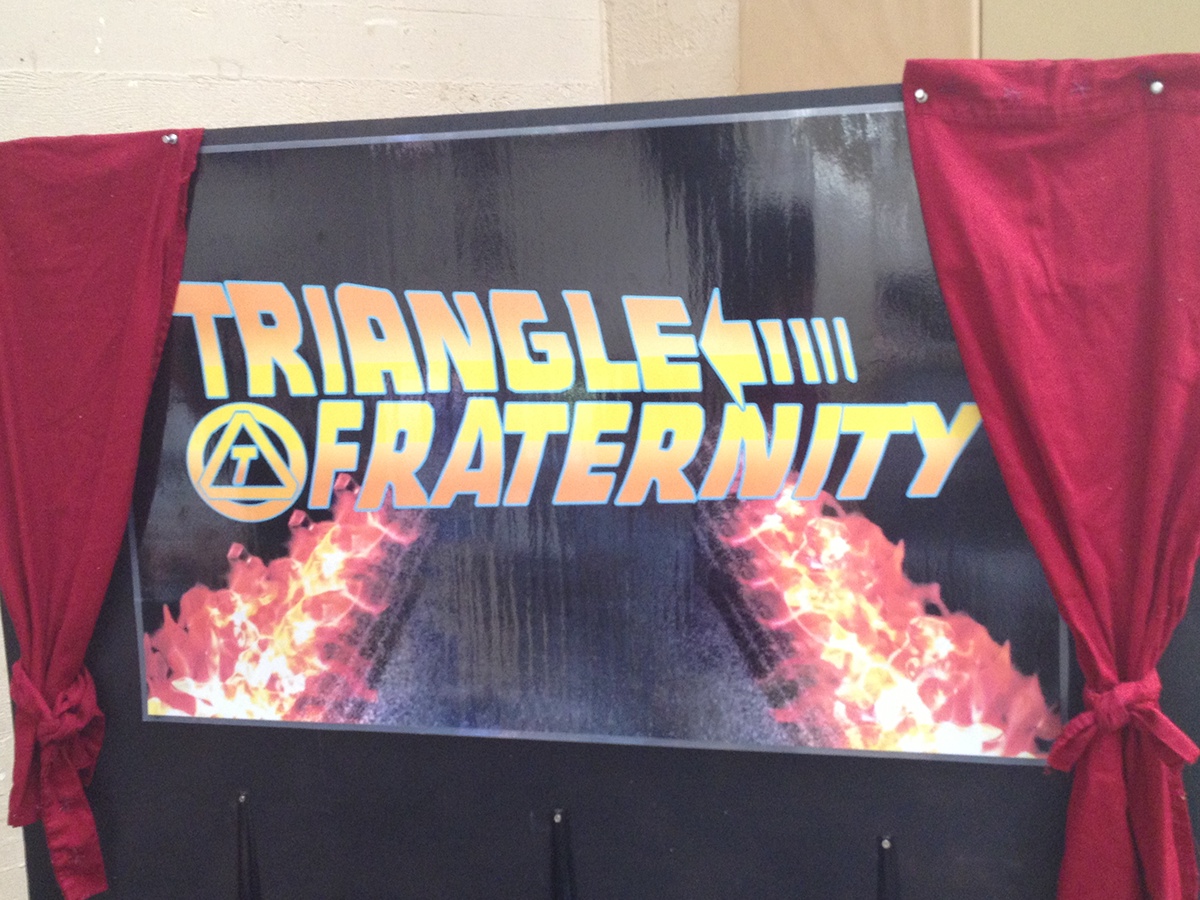
The banner as the opening screen of a movie.
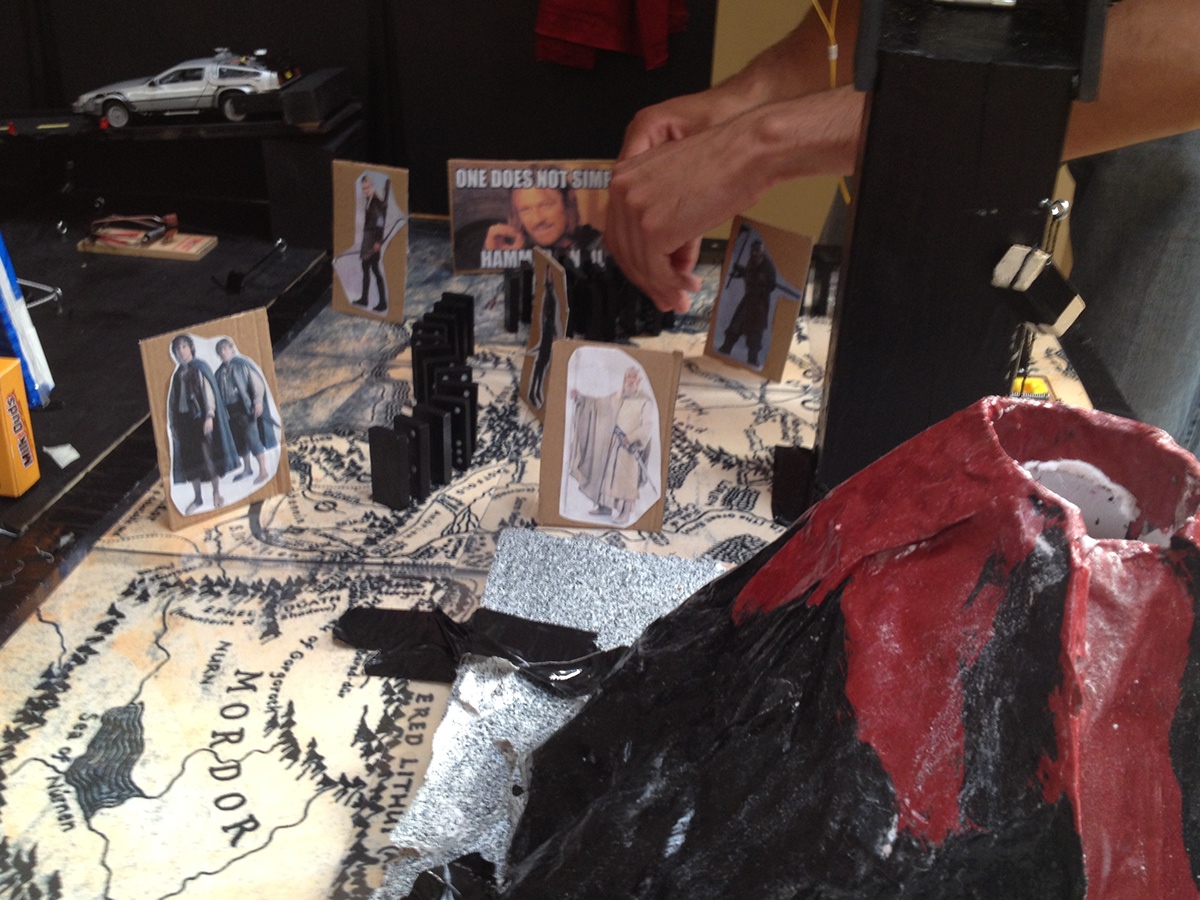
One does not simply...Hammer a nail.
Lord of the Rings. The starting step. Frodo and Sam journey their way to Mount Doom (in the form of Dominos), where when they throw the One ring to rule them all into the volcano, a chemical reaction of baking soda and vinegar simulates the eruption of the volcano.
Lord of the Rings. The starting step. Frodo and Sam journey their way to Mount Doom (in the form of Dominos), where when they throw the One ring to rule them all into the volcano, a chemical reaction of baking soda and vinegar simulates the eruption of the volcano.

Another view of Lord of the Rings.
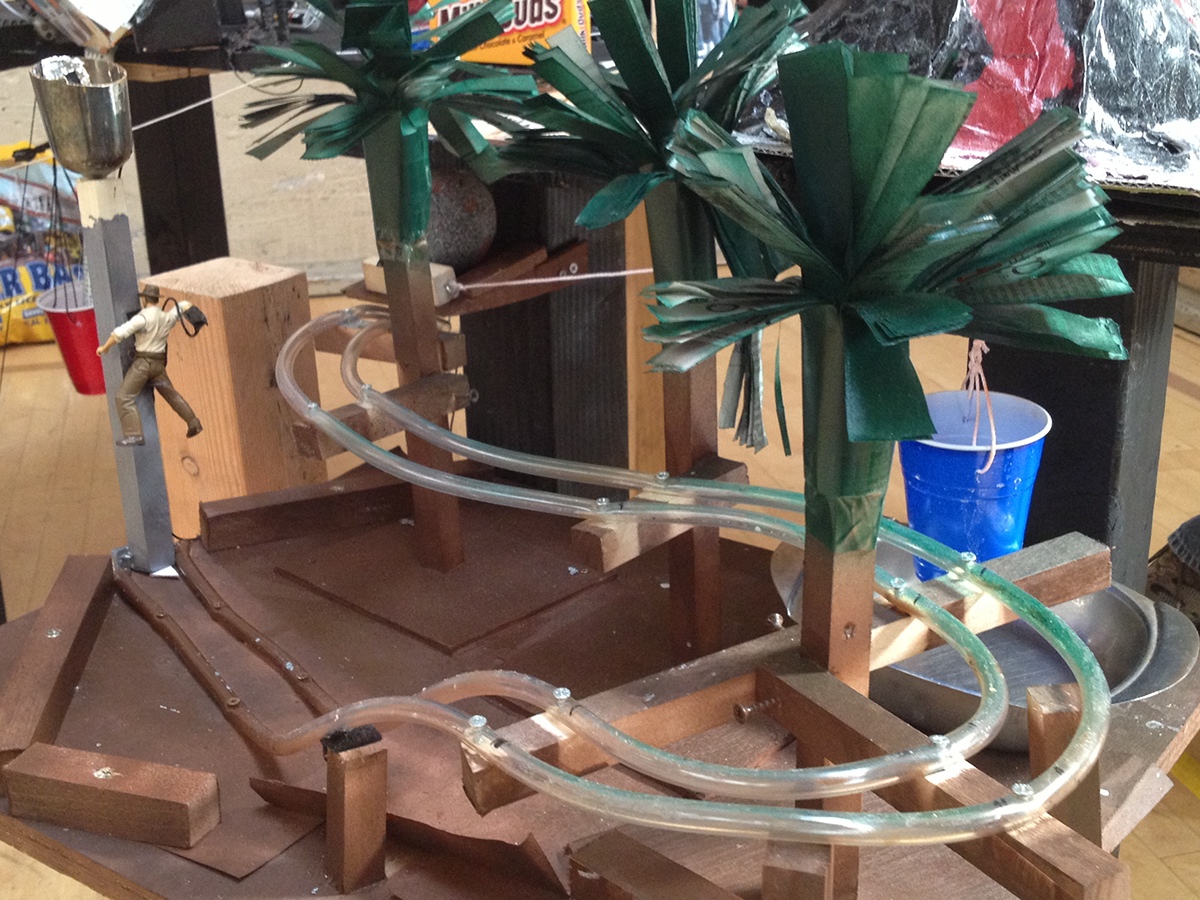
Indiana Jones. The eruption of Mount Doom triggers an earthquake which releases a boulder, which will knock down Indiana Jones who is climbing up the Holy Grail. Lava fills the cup which releases the stopping block of the boulder. The holy grail falls and completes a circuit, jump starting the super powered candy collidor.

The Matrix and Willy Wonka & the Chocolate Factory. Everlasting gobstoppers travel up the super powered candy collidor and are deflected by Neo, before they fall into the garbage chute (where the squirrels discard bad nuts).

The weight of the everlasting gobstoppers that end up in the garbage chute trigger the electric generator (Knex Micro Power Spring Motor) which winds up string until lightning crashes downward, raising Frankenstein up in a steady pace.

Popcorn makes good aesthetics and good food.
The Matrix. Neo from another angle. The mouse trap connected to him allows him to backflip away when he is scared by Frankenstein's awakening.
The Matrix. Neo from another angle. The mouse trap connected to him allows him to backflip away when he is scared by Frankenstein's awakening.

Back to the Future. After Neo's backflip, the Delorean blasts through so fast that fire lights up along the road (red LEDs).
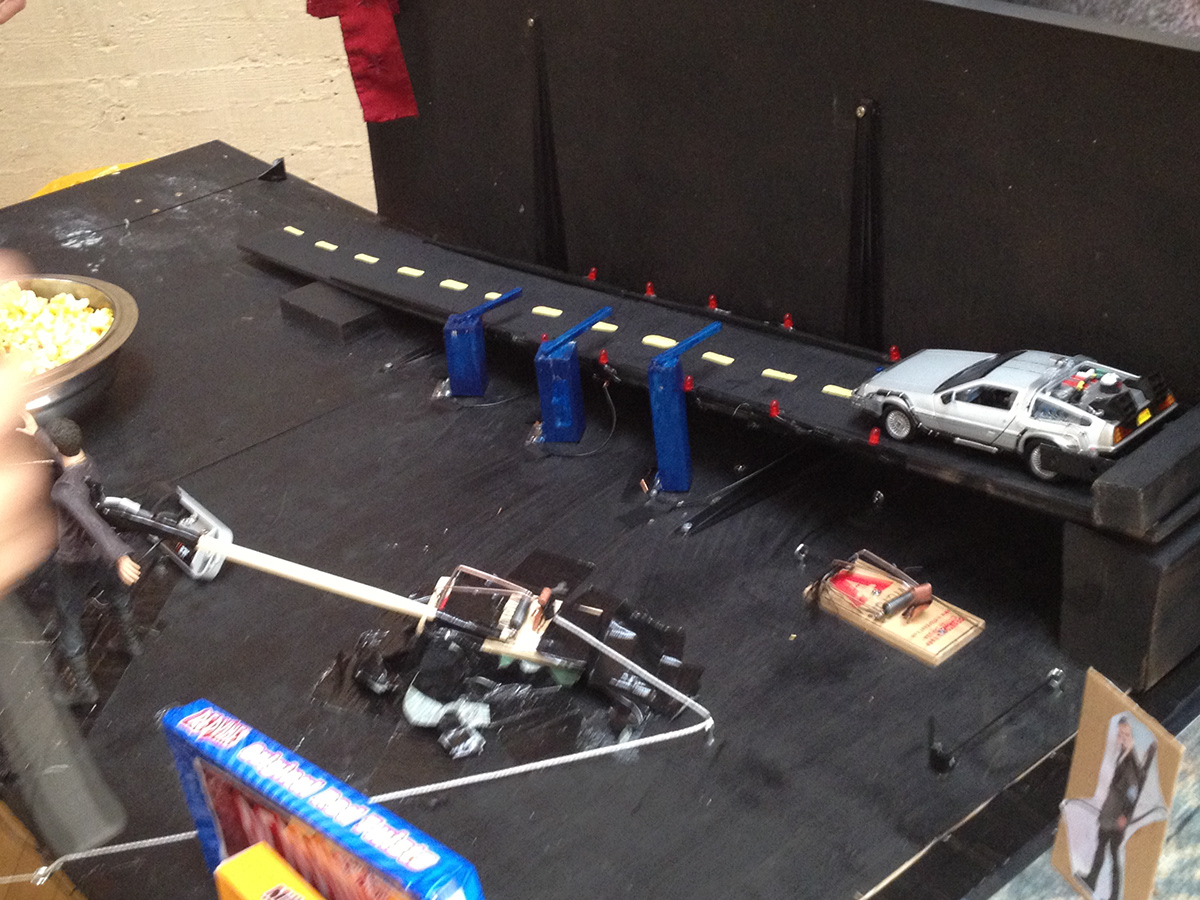
Another angle of the Matrix and Back to the Future.

The Avengers. The Delorean time travels to the present day, where the avengers team up to defeat Loki (nail). Hulk's Fist pounds on Captain America's Shield, which drops Thor's Hammer. Thor's hammer is the last step (hammer a nail).
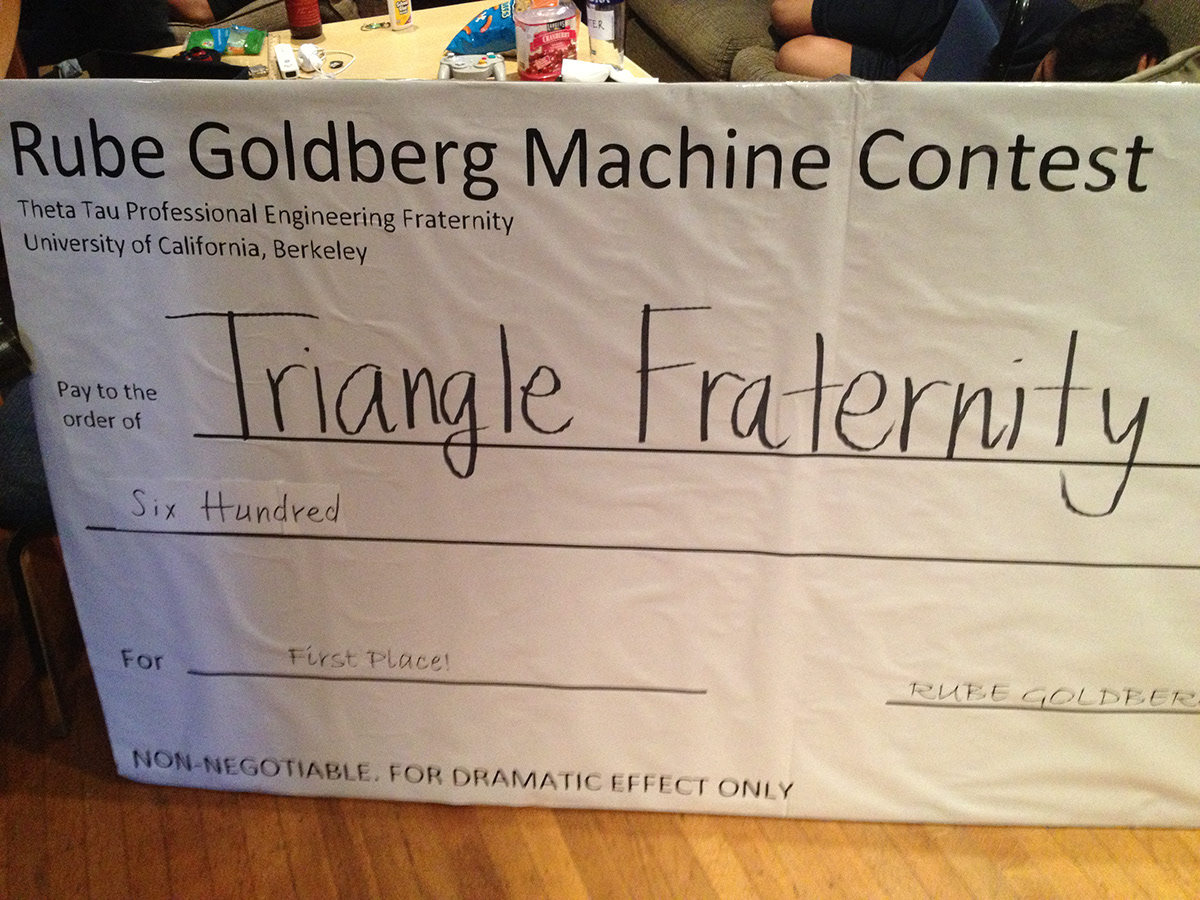
First Place!
